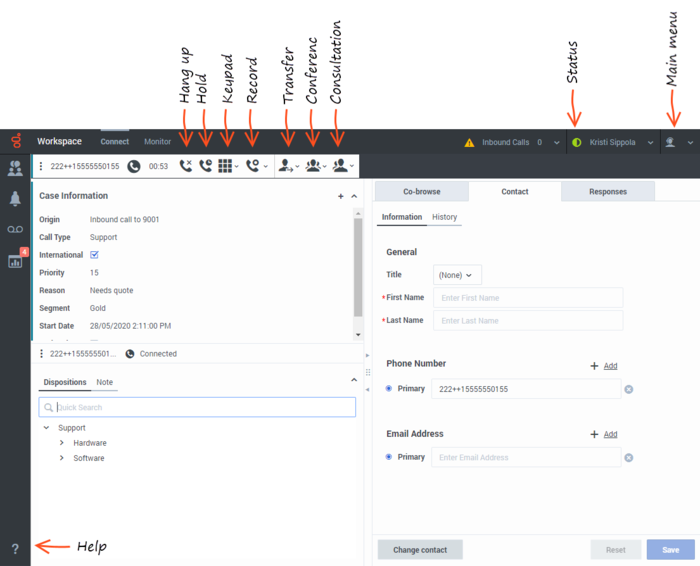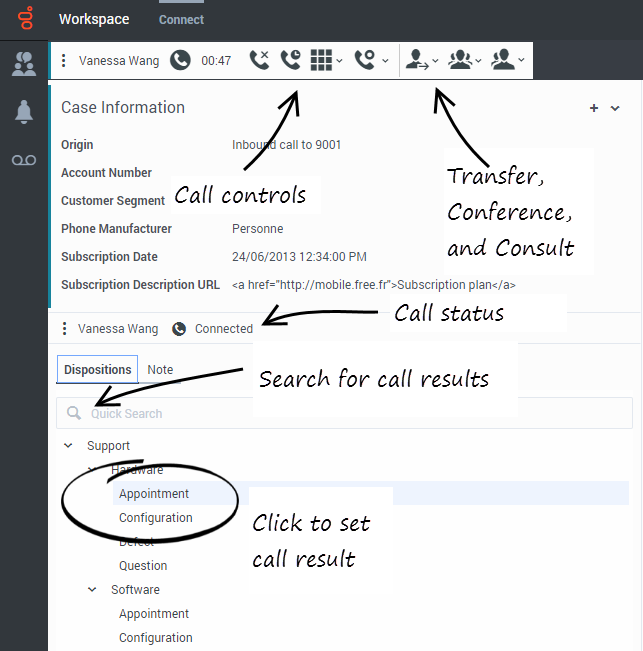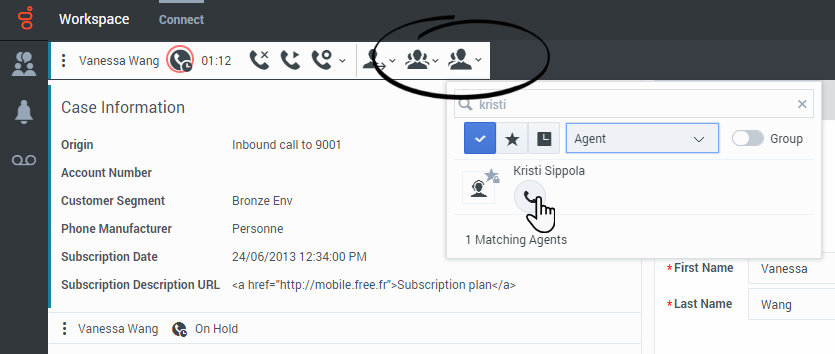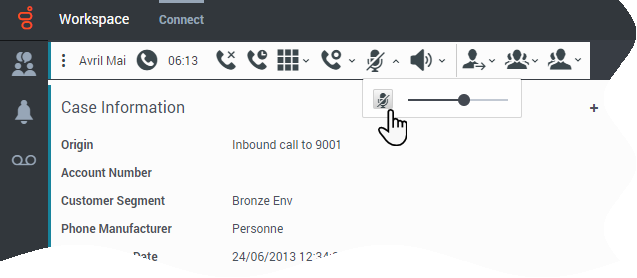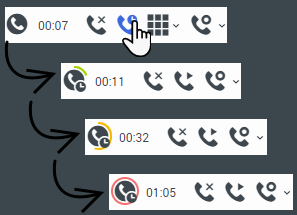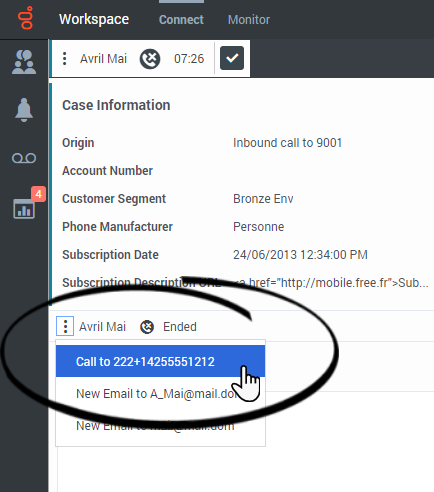Voice Calls
Contents
- 1 How do I handle an incoming call?
- 2 Videos about handling calls
- 3 Where can I get help to handle a call?
- 4 What other actions can I take during a call?
- 5 How do I control the volume of my headset and mute myself?
- 6 What do I do at the end of a call?
- 7 What happens when I put someone on hold?
- 8 How do I manually select a caller ID?
- 9 How do I record a call?
- 10 How do I forward my calls?
- 11 How do I call someone back?
- 12 What next?
- 13 Top 5 topics
The controls and features that let you handle voice interactions with contacts or team members.
- Due to continual changes to Agent Workspace, screen shots in this manual might show interface elements that are not yet available for this product or might not accurately reflect what you can access in the product when you use it.
- Some Agent Workspace features are available only for Genesys Multicloud CX users.
- Some Agent Workspace features are available only for Genesys Engage on-premises users.
- The Team Communicator toolbar in the Main Window view
- The Voice Interaction view (while you are handling an active call with a Contact)
How do I handle an incoming call?
What is a voice interaction?
A voice interaction is the Agent Workspace interface that lets you handle a voice call.
To start receiving calls, set your status on the Voice channel to Ready.What can I do with a voice interaction?
- Handle it myself
- Handle it myself with help
- Instantly transfer it (
 )
) - Transfer it after a consultation call. If you want to perform a warm transfer or a two-step transfer, click Consult to talk to the consultation target and then click Transfer (
 ) to transfer the call.
) to transfer the call. - End the call (
 )
)
How do I know when I have a call?
When you get a call, a pop-up notification is displayed on your desktop. You might also hear a ringing tone. The Interaction Notification view displays Case Data. Case Data can help you decide whether you Accept or Reject the call.
- Your account might be set up for auto-answer. In that case, calls are accepted for you automatically.
- In some environments, the Reject option is not available.
In some environments, before the call is connected and your contact hears your phone ringing you receive a call preview. The preview has the same appearance as the Interaction Notification view. The call preview lets you decide whether to connect to the call or put the call back into the queue. If a contact directly dials you, call preview is by-passed. The normal Interaction Notification is displayed for directly dialed calls, even if you are not in the Ready state.
What if the caller is Anonymous?
In some contact centers, inbound calls are anonymous. In this case, there is no information to identify the contact in the interaction view or in the Contact tab.
If an anonymous caller provides you with Personally Identifiable Information (PII) and it is your corporate policy to add the PII to the Contact tab, then the caller is no longer anonymous and Agent Workspace searches for the contact in the contact database. To assign the interaction to the contact, enter the PII into the contact search field, select the contact from the search results, then click Assign.
If no matching contact is found, click Add Contact (![]() ) to create a new contact. Add the contact information and click Save.
) to create a new contact. Add the contact information and click Save.
If you transfer, conference, or consult the call, it remains anonymous to the other party. The call also remains anonymous to Supervisors monitoring the call.
How do I expand or collapse panes to avoid scrolling?
To give yourself more room to work or to focus on a single pane, use the little chevrons (up/down arrows) to expand or collapse different parts of the interaction view:
Videos about handling calls
Here are some quick videos showing some of the things you can do while handling a call:
Overview of handling a voice call
How to transfer a call
How to transfer a call to an agent group
How to make a consultation call
How to use Team Communicator
How to dial a new call
Where can I get help to handle a call?
- To start a consultation click

- To start a conference click

If you want to perform a warm transfer or a two-step transfer, click Consult (![]() ) to talk to the consultation target and then click Transfer to transfer the call.
) to talk to the consultation target and then click Transfer to transfer the call.
What other actions can I take during a call?
You can:
- Record the call
- Hold the call by clicking
 and resume the call by clicking
and resume the call by clicking 
- Dial digits using the keypad (
 without using your phone. For instance, you can use this keypad dialer when you are navigating a phone system to send dial tones (DTMF).
without using your phone. For instance, you can use this keypad dialer when you are navigating a phone system to send dial tones (DTMF). - View and modify contact information in the Contact tab.
- View the contact's interaction history in the Contact tab.
- Sometimes Workspace is unable to assign a call to a contact or it assigns the call to the wrong contact. Your account might be set up to let you assign or change a contact in the Contact tab.
How do I control the volume of my headset and mute myself?
Depending on how your environment is set up, you might encounter different configurations of buttons:
What do I do at the end of a call?
When your call is finished you can perform the following actions:
- Click End Call (
 ) to hang up.
) to hang up. - Select a disposition code if required
- Mark Done by clicking Done (
 )
) - Change status as needed
What happens when I put someone on hold?
You can determine how long you have placed a caller on hold (if this feature is enabled).
After you click Hold (![]() ), a timer and progress bar begin to count the seconds that the call is on hold.
), a timer and progress bar begin to count the seconds that the call is on hold.
How do I manually select a caller ID?
When you make a call, you might have to choose a Caller Identification to be displayed on the phone of the contact. This feature might also be enabled for calls that you are transferring or conferencing.
The person you call receives the Caller ID you select. The previous Caller ID that you selected is selected by default. To hide your identity, you can select Anonymous if available. Ask your supervisor about when to use this feature.How do I record a call?
The Call Recording functionality enables you to record the current voice interaction with a contact or an internal target. Agent Workspace supports two different types of call recording: emergency recording and controlled call recording. Your system administrator sets up the type of call recording support in your environment.
If your account is set up for emergency recording, you can start and stop recording by using a single toggle button.
If your account is set up for controlled recording, you can start a recording, pause a recording, resume a recording, and end a recording.
In addition, your account might also be set up for automatic or system-guided recording. With automatic call recording, you receive a notification that recording is in progress.
Call recording enables you to perform the following functions:
- Record the call: Select Record the Call (
 ) to record a call. If your contact has opted out of call recording, this button is not available and a message is displayed informing you that the call is not being recorded.
) to record a call. If your contact has opted out of call recording, this button is not available and a message is displayed informing you that the call is not being recorded. - Stop recording the call: Select Stop Recording the Call (
 ) to stop recording a call that you are currently recording.
) to stop recording a call that you are currently recording. - Pause recording the call: Select Pause Recording the Call (
 ) to pause recording a call that you are currently recording. Not all agents might have this feature.
) to pause recording a call that you are currently recording. Not all agents might have this feature. - Resume recording the call: Select Resume Recording the Call (
 ) to resume recording a call that is currently paused recording.
) to resume recording a call that is currently paused recording.
When you are recording a call, the call icon in the connected-parties area changes to red.
When you pause a call recording, the red call icon changes back to unavailable.
A Tooltip indicates both that the call is being recorded and the length of time of the recording.
A call-recording icon (![]() ) is displayed in the title bar of the Main View when a call recording is active.
) is displayed in the title bar of the Main View when a call recording is active.
How do I forward my calls?
To forward calls to a different extension or phone number, on the selected media channel, in the Forward column, click No Active Forward and Forward.
This action opens the Forward dialog box. Enter the number to which you want to forward your calls and click Apply. Click Cancel to return to the My Channels tab without forwarding your calls.
If you have an Active Forward set and you want to disable it, on the voice channel, in the Forward column, select Forwarded to <number>, then select Cancel Forward to <number>.
In the Cancel Forward dialog box, select Yes to cancel the forward. Canceling the forward removes the active forward and changes the Forward status to No Active Forward. To keep the forward active, select No.
How do I call someone back?
If you are handling a call and the call drops, you can call the contact back in one of two ways:
- Open Team Communicator, filtering for Recent Calls (
 ), then select the contact.
), then select the contact. - Open the Party Action menu and select the contact's phone number from the pop-up menu.

